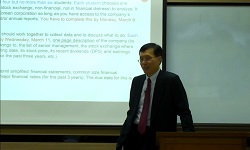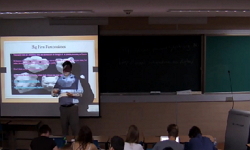Based on a previous literature about hospital capital structure(Shyam- Sunder & Myers, 1999), this study attempted comparison and analysis on whether the forecast of trade-off and pecking order theory could be validated in hospital`s capital structure...
http://chineseinput.net/에서 pinyin(병음)방식으로 중국어를 변환할 수 있습니다.
변환된 중국어를 복사하여 사용하시면 됩니다.
- 中文 을 입력하시려면 zhongwen을 입력하시고 space를누르시면됩니다.
- 北京 을 입력하시려면 beijing을 입력하시고 space를 누르시면 됩니다.

상충관계이론과 자본조달순위이론에 기초한 병원 자본조달행태 분석 = Hospital`s Financing Behaviors Based on Comparative Analysis of Trade-off Theory and Pecking Order Theory
한글로보기https://www.riss.kr/link?id=A75691185
- 저자
- 발행기관
- 학술지명
- 권호사항
-
발행연도
2006
-
작성언어
-
- 주제어
-
KDC
300
-
등재정보
KCI등재
-
자료형태
학술저널
- 발행기관 URL
-
수록면
61-86(26쪽)
-
KCI 피인용횟수
1
- 제공처
-
0
상세조회 -
0
다운로드
부가정보
다국어 초록 (Multilingual Abstract)
Based on a previous literature about hospital capital structure(Shyam- Sunder & Myers, 1999), this study attempted comparison and analysis on whether the forecast of trade-off and pecking order theory could be validated in hospital`s capital structure. First, this study analyzed whether hospitals follow the priority for each capital source as suggested by pecking order theory under lack of capital running in hospital. Next, it analyzed whether debt level is regressed on the average to target debt level so as to verify the validity of trade-off theory. Finally, it also analyzed possible associations between debt level and determinants of capital structure as adopted in static trade-off theory, so as to verify relative advantages of these two theories about hospital capital structure. The analysis over whole period showed that both trade-off theory and pecking order theory isn`t supported particularly. This mean that each hospital`s financing behaviors is different and that has not dominant financing behaviors. In the midst of separation of dispensary from medical practice, medical institutions in Korea first finances funds required using retained earnings and then use liabilities. however pecking order theory is supported, the preference of long-term liabilities and short-term liabilities is not clear. In addition, considering that debt level is in no average regression to target debt ratio, it is found that hospital capital structure following trade-off theory turns into that subject to pecking order theory via the separation of dispensary from medical practice.
동일학술지(권/호) 다른 논문
-
전공의와 간호사,의료기사간의 인간관계 갈등과 의사소통에 관한 연구
- 한국병원경영학회
- 김용순 ( Yong Soon Kim )
- 2006
- KCI등재
-
서번트 리더십이 병원종사자 직무만족과 조직몰입에 미치는 영향
- 한국병원경영학회
- 이은주 ( Eun Ju Yi )
- 2006
- KCI등재
-
직무요구-통제 모형에 의한 간호사의 소진(Burnout)에 관한 연구
- 한국병원경영학회
- 박상언 ( Sang Eon Park )
- 2006
- KCI등재
분석정보
인용정보 인용지수 설명보기
학술지 이력
| 연월일 | 이력구분 | 이력상세 | 등재구분 |
|---|---|---|---|
| 2022 | 평가예정 | 재인증평가 신청대상 (재인증) | |
| 2019-01-01 | 평가 | 등재학술지 유지 (계속평가) |  |
| 2016-01-01 | 평가 | 등재학술지 선정 (계속평가) |  |
| 2015-01-01 | 평가 | 등재후보학술지 유지 (계속평가) |  |
| 2013-01-01 | 평가 | 등재후보학술지 유지 (기타) |  |
| 2012-01-01 | 평가 | 등재후보학술지 유지 (기타) |  |
| 2011-01-01 | 평가 | 등재후보 1차 PASS (등재후보1차) |  |
| 2010-01-01 | 평가 | 신청제한 (등재후보1차) |  |
| 2009-01-01 | 평가 | 등재후보 1차 FAIL (등재후보2차) |  |
| 2008-01-01 | 평가 | 등재후보 1차 PASS (등재후보1차) |  |
| 2007-01-01 | 평가 | 등재후보학술지 유지 (등재후보1차) |  |
| 2006-01-01 | 평가 | 등재후보 1차 FAIL (등재후보2차) |  |
| 2005-01-01 | 평가 | 등재후보 1차 PASS (등재후보1차) |  |
| 2003-07-01 | 평가 | 등재후보학술지 선정 (신규평가) |  |
학술지 인용정보
| 기준연도 | WOS-KCI 통합IF(2년) | KCIF(2년) | KCIF(3년) |
|---|---|---|---|
| 2016 | 0.76 | 0.76 | 0.66 |
| KCIF(4년) | KCIF(5년) | 중심성지수(3년) | 즉시성지수 |
| 0.55 | 0.55 | 1.13 | 0.1 |




 ScienceON
ScienceON KISS
KISS






